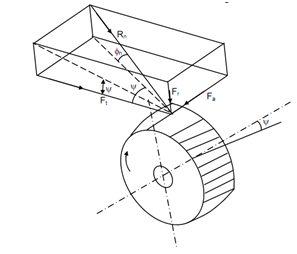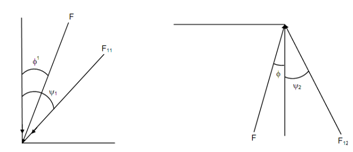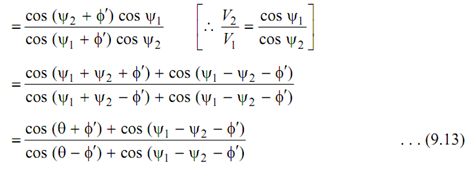Forces and Efficiency:
Whereas transmitting power, the force exerted through a helical gear on its mating gear behaves normal to the contracting surfaces if friction is negligible. This normal force contains three components. Given figure shows normal force 'Rn'. It may be resolved into three components namely, axial force, tangential force and radial force.
Tangential component, ' Ft ' = Rn cos φn cos ψ
Radial component, ' Fr ' = Rn sin φn
Axial component, ' Fa ' = Rn cos φn sin ψ . . . (9.12)

While two helical or spiral gears are in mesh the force diagrams of gear 1 & gear 2 are given in given figure. The friction force will be in horizontal plane and equal to μ Fn and shall behave opposite to the direction of velocity of sliding. Assume F is the resultant of Fn and μ Fn that is inclined with angle of friction say φ′ having Fn. Assume helix angles of gear 1 & gear 2 be ψ1 and ψ2, respectively. The angle among shaft axes, θ= ψ1 + ψ2.

Thus, for gear 1, tangential force, Ft1 = F cos (ψ1 - φ′) and for gear 2, tangential force,
F t2 = F cos (ψ + φ′).
Assume tangential velocities for gear 1 and gear 2 is respectively V1 and V2.
Input power = Ft1 × V1
Output power = Ft2 × V2
Efficiency, η


The efficiency shall be maximum if,
cos (ψ1 - ψ2 - φ′) = 1 or ψ1 - ψ2 - φ′ = 0
or, ψ1 = ψ2 + φ′ or ψ = θ+ φ′
 . . . (9.14)
. . . (9.14)